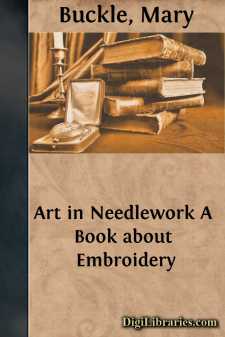Categories
- Antiques & Collectibles 13
- Architecture 36
- Art 48
- Bibles 22
- Biography & Autobiography 813
- Body, Mind & Spirit 142
- Business & Economics 28
- Children's Books 16
- Children's Fiction 13
- Computers 4
- Cooking 94
- Crafts & Hobbies 4
- Drama 346
- Education 46
- Family & Relationships 57
- Fiction 11829
- Games 19
- Gardening 17
- Health & Fitness 34
- History 1377
- House & Home 1
- Humor 147
- Juvenile Fiction 1873
- Juvenile Nonfiction 202
- Language Arts & Disciplines 88
- Law 16
- Literary Collections 686
- Literary Criticism 179
- Mathematics 13
- Medical 41
- Music 40
- Nature 179
- Non-Classifiable 1768
- Performing Arts 7
- Periodicals 1453
- Philosophy 64
- Photography 2
- Poetry 896
- Political Science 203
- Psychology 42
- Reference 154
- Religion 513
- Science 126
- Self-Help 84
- Social Science 81
- Sports & Recreation 34
- Study Aids 3
- Technology & Engineering 59
- Transportation 23
- Travel 463
- True Crime 29
Art in Needlework A Book about Embroidery
by: Mary Buckle
Categories:
Description:
Excerpt
Embroidery may be looked at from more points of view than it would be possible in a book like this to take up seriously. Merely to hover round the subject and glance casually at it would serve no useful purpose. It may be as well, therefore, to define our standpoint: we look at the art from its practical side, not, of course, neglecting the artistic, for the practical use of embroidery is to be beautiful.
The custom has been, since woman learnt to kill time with the needle, to think of embroidery too much as an idle accomplishment. It is more than that. At the very least it is a handicraft: at the best it is an art. This contention may be to take it rather seriously; but if one esteemed it less it would hardly be worth writing about, and the book, when written, would not be worth the attention of students of embroidery, needleworkers, and designers of needlework to whom it is addressed. It sets forth to show what decorative stitching is, how it is done, and what it can do. It is illustrated by samplers of stitches; by diagrams, to explain the way stitches are done; and by examples of old and modern work, to show the artistic application of the stitches.
A feature in the book is the series of samplers designed to show not only what are the available stitches, but the groups into which they naturally gather themselves, as well as the use to which they may be put: and the back of the sampler is given too: the reader has only to turn the page to see the other side of the stitching—which to a needlewoman is often the more helpful. Lest that should not be enough, the stitches are described in the text, and a marginal note shows at a glance where the description is given. This should be read needle and thread in hand—or skipped. Samplers and other examples of needlework are uniformly on a scale large enough to show the stitch quite plainly. The examples of old work illustrate always, in the first place, some point of workmanship; still they are chosen with some view to their artistic interest.
In other respects Art is not overlooked; but it is Art in harness. Design is discussed with reference to stitch and stuff, and stitch and stuff with reference to their use in ornament. It has been endeavoured also to show the effect needlework has had upon pattern, and the ways in which design is affected by the circumstance that it is to be embroidered.
The joint authorship of the work needs, perhaps, a word of explanation. This is not just a man's book on a woman's subject. The scheme of it is mine, and I have written it, but with the co-operation throughout of Miss Mary Buckle. Our classification of the stitches is the result of many a conference between us. The description of the way the stitches are worked, and so forth, is my rendering of her description, supplemented by practical demonstration with the needle. She has primed me with technical information, and been always at hand to keep me from technical error. With reference to design and art I speak for myself.
My thanks are due to the authorities at South Kensington for allowing us to handle the treasures of the national collection, and to photograph them for illustration; to Mrs. Walter Crane, Miss Mabel Keighley, and Miss C. P. Shrewsbury, for permission to reproduce their handiwork; to Miss Argles, Mrs. Buxton Morrish, Colonel Green, R.E., and Messrs. Morris and Co., for the loan of work belonging to them; and to Miss Chart for working the cross-stitch sampler....


